A new website offers a wealth of information about steel design and application
A new online encyclopedia for anyone designing with steel has been launched by the steel construction sector.
Launched last month, the website, www.steelconstruction.info. has been developed over the last two years by the British Constructional Steelwork Association (BCSA), TATA Steel and the Steel Construction Institute and brings together all the key steel design and construction information into one place.
“It’s a collaborative effort by experts from across the steel construction sector;’ says project manager Chris Dolling. “The intention is for it to be the first port of call for anyone who wants to know anything about steel construction.
While there was previously a lot of good information on various websites, it wasn’t always as easy to find as it perhaps should have been. The idea is to bring it all together in one place so it’s much more accessible.”
‘The idea is to bring it all together in one place’
More than 100 interlinked articles written by industry experts are on the website, with content organised by sectors and topics.
Resources include key industry documents such as the Blue Book for steel section design and the Green Books on structural steelwork connections. Information on Eurocode compliance is also available, plus the Target Zero guidance on sustainable construction.
There is also extensive information and advice on topical issues including thermal mass, fire engineering, lifecycle assessment and steelwork costs. Best practice is demonstrated by the winners of the Structural Steel Design Awards. There are also product and service directories, and advice on health and safety.
The site aims to keep users up to date on the latest research on steel design, with content on hot topics such as structural steel cost, lifecycle assessment and embodied carbon, and thermal mass.
In addition to the search facility, there are two interactive mechanisms built in to encourage a dialogue between users and the experts behind the site. If users can’t find what they need, they can use the “Did Not Find” button, and the site partners will consider adding the required information. A “Report Errors” button will allow users to point out what they feel are mistakes.
The idea is to bring it all together in one place
The webmaster will then give feedback and, if necessary, correct the site.
“Share functions are also on the site,” says Dolling. “You have to move with the times. If architects find anything they like there’s the ability to create a PDF file, which can then be shared with colleagues and friends. You can also follow the site on ‘Twitter or join a LinkedIn group to keep up to date with additional information and what others are saying.”
A number of online CPD presentations are also included, which enable the user to take a test and download a certificate for their records.
The hope is to attract around 50,000 unique visitors per month to the new website, which is at www.steelconstruction.info
Case studies

The Co-operative Group’s new 16-storey headquarters in Manchester, designed by 3DReid, is among more than 40 case studies of steel-framed buildings on the new steel website.
The building - which will be the first in the city to achieve a Breeam “outstanding” rating contains steelwork weighing 3,200 tonnes, installed by Fisher Engineering. It will provide 30,000sq m of office space, and is due to open this autumn.
Each building type on the website features five or six case studies, including award-winning buildings such as Foggo Associates’ Cannon Place, and the St Botolph Building designed by Grimshaw Architects, both in London, as well as CZWG’s distinctively curved Maggie’s Centre in Nottingham.
Acoustics
Technical advice on how to achieve the best acoustic performance in steel-framed buildings is also included on the new website.
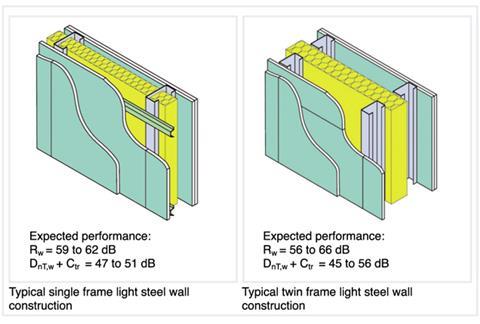
This sets out the acoustic regulations for various building uses such as residential, schools, hospitals and commercial buildings, and looks in detail at different types of wall, floor and ceiling construction and their integration, such as the junctions between wall and floor. There are also links to other technical resources, further reading, and CPDs.
Steel insights
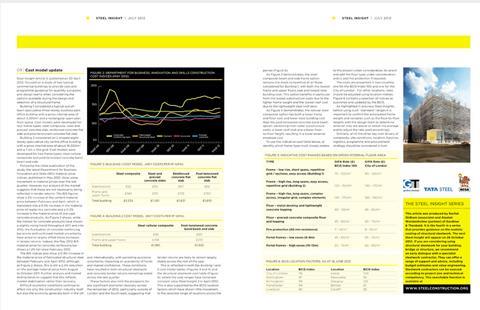
SteelConstruction.info also includes the Steel Insight series of quarterly analysis on structural steelwork by cost consultant Gardiner Theobald. The series provides guidance across a range of cost-related topics and market sectors for quantity surveyors and others interested in the cost of steelwork.
Each Steel Insight includes indicative prices for steelwork - for example, on the structural options for both a business park office and a city centre office. The Latest update shows that the total cost for the steel-framed solutions was around 5% lower than the comparable concrete options. Costs are also broken down into storey heights, frame types and site Location.
Each article in the Steel Insight series contains indicative prices for steelwork and focused guidance on a key market sector.
Market share surveys commissioned by the BCSA and Tata Steel, show that steel frames have a 67.7% share of the multi-storey buildings sector compared with concrete at 20.7%, load-bearing masonry at 6.6%, precast concrete at 2.8%, and timber at 2.3%. For multi-storey offices alone, steel has 69.1% of the market.
Research also shows the continuingly tough state of the market, with the total market contracting by a further 6.3% in 2011. Overall floor area constructed in all multi-storey buildings is only 71% ofthe size of the market at its peak of 2008.
Online CPD
The site currently offers 12 online CPO courses as well as information on how to access face-to-face inhouse technical seminars.
Those who opt to do the course online can watch the module on the subject, and then take an online multiple choice test, which they must pass by 80%.
They can then print off a CPD certificate.
“It’s a much quicker way of doing CPD and you don’t have to pay, so hopefully it will become a popular part of the website,” says market development director Alan Todd.
The website sets out all CPD modules available, both in-house and online.
Subjects include sustainability, acoustics, design for fire, and weathering steel, a particularly popular topic of enquiry from architects.
Target zero
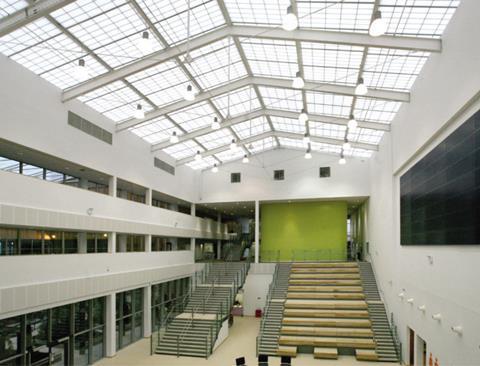
Resources also include the Target Zero guidance on the design and construction of sustainable low and zerocarbon buildings. This looks at five building types: a school, a high-rise office, a supermarket, a mixed-use development and a large distribution warehouse.
The research focused on the use of energy-efficiency measures and low and zero-carbon technologies to improve environmental performance, and how this might be influenced by alternative structural forms.
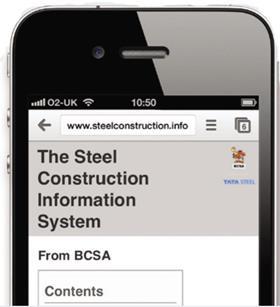
Find a steel contractor app
The site has a link to the searchable Find a Steel Contractor function on the BCSA’s own website, which is also available as an app for use on iPhones and iPads.
The directory lists all BCSA members, and is searchable by categories such as geography, type of work undertaken and size of project and certification requirements
Thermal mass
Technical information is available on how thermal mass - also known as fabric energy storage - can be achieved just as easily using a steel frame.
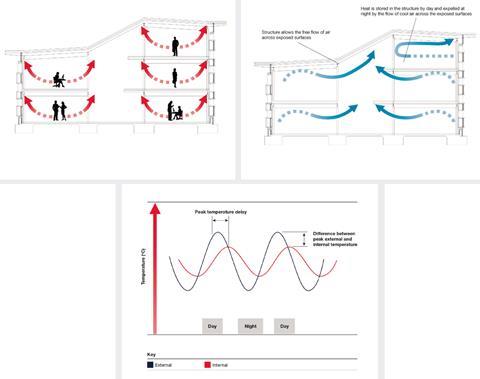
This includes research considering the relative thermal merits of steel and concrete structures, including the optimum thickness of concrete slab for thermal mass in both steel and concrete buildings.
Research indicates that the first 25mm plays the greatest role, with very little thermal performance gain beyond a thickness of 100mm.
Technical information available on the site explains how thermal mass works, as well as examining the relative thermal merits of steel and concrete structures.
Postscript

In association with The British Construction Steelwork Association and Tata Steel




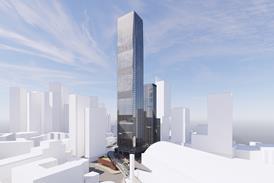








No comments yet